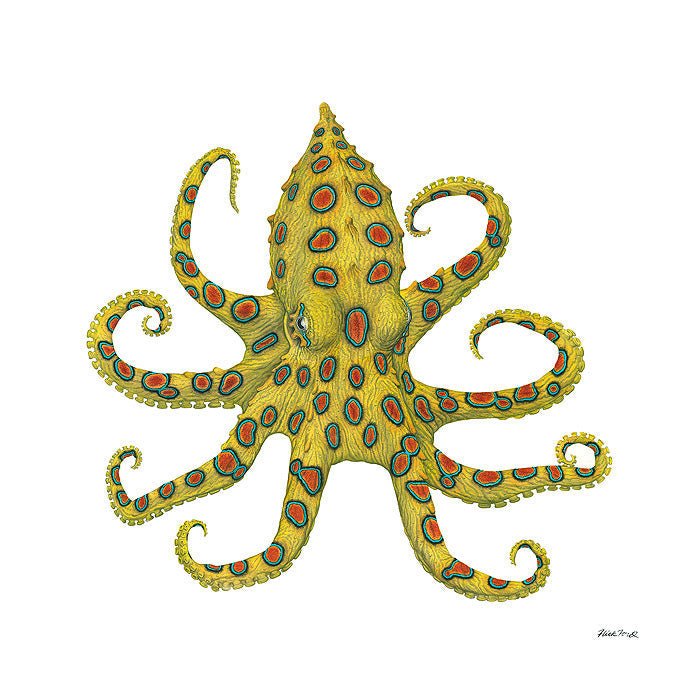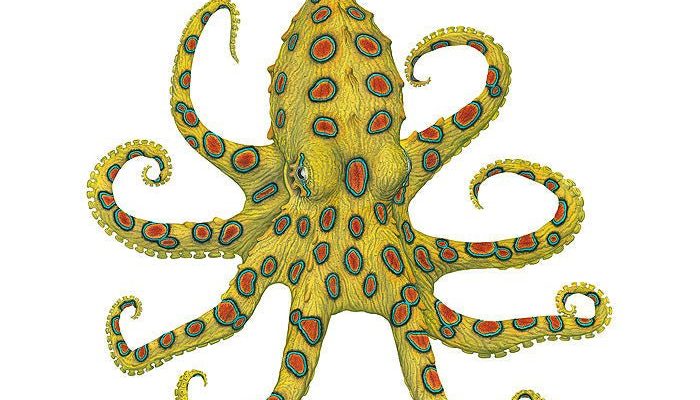
Let’s dive into the history and adaptations of these remarkable octopuses. From their ancient ancestors to their modern-day survival techniques, the blue-ringed octopus’s evolution tells a story of resilience, complexity, and natural wonder. So, grab a cup of coffee as we explore how this little marvel of the sea came to be.
What Are Blue-Ringed Octopuses?
Blue-ringed octopuses are small marine animals belonging to the genus *Hapalochlaena*. These creatures are often found in shallow waters around the Pacific and Indian Oceans, particularly in regions like Australia and Japan. You might be wondering why they are so unique. Well, their size is striking; they measure just about 4 to 5 inches when fully grown. But don’t let their small stature fool you!
These octopuses are best known for their vibrant blue rings, which act as a warning sign. When threatened, they flare up these rings, signaling potential predators that they possess a potent venom. This venom contains a powerful neurotoxin called *tetrodotoxin*, which can be lethal to humans. Honestly, it’s a vivid reminder of how beauty in the wild often comes with a dark twist.
Their diet primarily consists of crustaceans, and they use their intelligence and quick reflexes to capture prey. The way they hunt is quite spectacular. They ambush their meals with rapid strikes—almost like a blink-and-you-miss-it moment.
A Glimpse into Their Ancestors
To appreciate the blue-ringed octopus, it helps to understand its evolutionary roots. The ancestors of modern octopuses date back over 300 million years. These early ancestors were very different from the creatures we see today. They had hard shells and lived in the ocean’s depths.
Over time, octopuses evolved to adapt to various environments. The shift from rigid shells to more flexible bodies allowed them to access new habitats. This change made them better hunters, as they could squeeze into tight spaces to evade predators or capture prey. You might think of them as the ultimate escape artists of the animal kingdom.
The blue-ringed octopus, in particular, branched off from other octopus species around 6 to 15 million years ago. This timeline reflects a significant moment in their evolution, as they developed unique adaptations that set them apart. Their ability to exhibit color-changing capabilities is a fascinating aspect of their evolution that ties back to their need for camouflage and communication.
The Venomous Defense Mechanism
One of the most remarkable features of the blue-ringed octopus is its venomous bite. When you think about evolution, survival strategies often come to mind. For many predators, defense mechanisms are crucial. The blue-ringed octopus has developed one of the most potent venoms in the animal kingdom.
The venom contains *tetrodotoxin*, which is more toxic than cyanide. It blocks sodium channels in the nervous system, resulting in paralysis. This ensures that once they bite, their prey can’t escape. For humans, this venom can cause serious health issues, including respiratory failure. You might be wondering, why evolve such a dangerous trait?
The answer lies in survival. By being venomous, they deter predators and enable themselves to feed more effectively. They don’t spend their time looking for food—instead, they become the hunters. This clever strategy has helped the blue-ringed octopus survive in competitive marine environments.
Adaptations for Camouflage
The blue-ringed octopus doesn’t just rely on venom for survival; it also has impressive camouflage abilities. This little creature can change its skin color and texture almost instantaneously to blend in with its surroundings. Imagine being able to wear your environment like a cloak!
This ability comes from special skin cells called *chromatophores*. These cells contain pigments that can expand or contract, allowing the octopus to display a wide range of colors and patterns. This skill not only helps them evade predators but also allows them to communicate with other octopus species.
Interestingly, their color changes can signal various messages. For example, when they feel threatened, the blue rings appear vividly against their skin. In contrast, they may appear muted when relaxed, blending in seamlessly with the rock or coral backdrop. It’s a brilliant example of how evolution equips creatures with the tools they need to thrive in nature.
Habitat: Where Do They Live?
Blue-ringed octopuses typically inhabit shallow coastal waters, rocky reefs, and tide pools. They prefer environments where they can hide from potential threats while hunting for food. The combination of these habitats provides them with an abundance of prey while offering safety against predators.
You might find them residing in sandy or muddy substrates, where they can easily bury themselves. This not only serves as camouflage but also provides a strategic advantage against larger predators. Their choice of habitat is a testament to their evolutionary journey, showcasing how their environments influence their behaviors and adaptations.
The preservation of their habitats is essential. As humans, we impact the health of our oceans. Pollution and climate change pose serious threats to their ecosystems. If these habitats diminish, it could jeopardize the future of blue-ringed octopuses and other marine life that depend on these environments.
Conservation Efforts and Future Outlook
As we learn more about the blue-ringed octopus, it’s crucial to think about their conservation. These little creatures are not endangered, but their habitats face various threats from human activities. Overfishing, climate change, and habitat destruction can impact their populations and health.
Scientists are working hard to monitor and protect marine ecosystems. Conservation efforts focus on creating marine protected areas and promoting sustainable fishing practices. Every action counts, from reducing pollution to raising awareness about ocean conservation.
The future of the blue-ringed octopus, like many species, rests on our shoulders. By embracing eco-friendly practices and supporting conservation programs, we can help ensure these beautiful and fascinating creatures continue to thrive in their natural environments.
Final Thoughts on the Blue-Ringed Octopus
The evolutionary journey of the blue-ringed octopus is a captivating tale filled with adaptations, survival strategies, and the beauty of nature. From their ancient ancestors to their current state of elegance and danger, these octopuses remind us of the wonders of evolution.
Whether you admire their striking appearance or marvel at their unique adaptations, understanding the blue-ringed octopus enriches our knowledge of marine life. As we continue to explore and learn, let’s also commit to protecting the environments that sustain these mesmerizing creatures. Remember, the ocean’s treasures, like the blue-ringed octopus, need our help to flourish.

